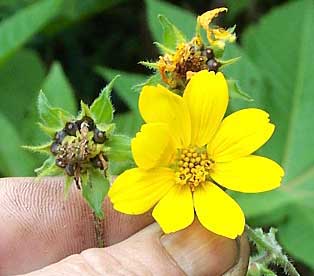Excerpts from Jim Conrad's
Naturalist Newsletter
from the November 12, 2007 Newsletter issued from Yerba Buena Clinic just outside Pueblo Nuevo Solistahuacan, Chiapas, MÉXICO
about 1740 meters in elevation, ± LAT. 17° 11' 27"N, LONG. -92° 53' 35"W
SMALLANTHUS MACULATUS
 In an earlier Newsletter I described Inés's pretty, weedy field of red-flowered Botil Beans. Lately bright yellow patches have emerged within the broad canvas of dark green splattered with bean-flower crimson. The yellow swaths remind me exactly of late fall in eastern North America when certain fields prettily erupt with large populations of yellow-flowered Spanish Needles. In fact, I'd been assuming that these were Spanish Needles in Inés's field, if not the same weedy northern species then something close to it. But then finally I took a close look at a blossom and saw what's shown at the top of this page.
In an earlier Newsletter I described Inés's pretty, weedy field of red-flowered Botil Beans. Lately bright yellow patches have emerged within the broad canvas of dark green splattered with bean-flower crimson. The yellow swaths remind me exactly of late fall in eastern North America when certain fields prettily erupt with large populations of yellow-flowered Spanish Needles. In fact, I'd been assuming that these were Spanish Needles in Inés's field, if not the same weedy northern species then something close to it. But then finally I took a close look at a blossom and saw what's shown at the top of this page.
To be fascinated by what's shown in that picture you need to be acquainted with basic composite-flower anatomy, for both Spanish Needles and this flower are composites, or members of the Composite Family. You may want to review my composite-flower anatomy page at www.backyardnature.net/fl_comps.htm.
There you're reminded how each composite "flower" is actually a cluster of tiny flowers, each flower with male and female parts. The tiny flowers can be of two types: "Ray flowers" and "disk flowers." Some composite blossoms produce both types, some have only ray and some only disk. In the picture, the outer "petals" are ray flowers while the blossom's "eye" is composed of closely packed disk flowers.
This flower's peculiarity is that its ray and disk flowers produce "seeds" (actually special fruits called achenes) exactly opposite to the way it's usually done. The iconic composite blossom with both ray and disk flowers is the sunflower. You know that sunflower "seeds" (the achene fruits) are produced in the sunflower blossom's broad "eye," each disk flower producing a single achene. You may not have realized that the sunflower's yellow ray flowers radiating from the eye are sterile -- produce no fruits.
In contrast, in this Spanish-Needle-like flower in Inés's bean patch, disk flowers in the "eye" are sterile (stamens producing pollen but ovaries remaining undevloped) while each ray produce an ovary that develops into an achene. Not only that, but the achenes are whoppers -- big, roundish, shiny things. If you look back at the picture you'll see how they form a circle around the steril eye, like little black peas.
Especially in the top flower you can see that a few achenes have plucked from the circle. Such oversized fruits must represent quite a meal to a small, seed-eating bird. Nearby a small flock of Black-headed Siskins appeared to be waiting for me to leave the patch of yellow flowers and I'll bet that they had those plump achenes on their minds.
So, the plant is SMALLANTHUS MACULATUS. Usually when you identify species in the huge Composite or Aster Family you need to pay attention to technical details, but in the above picture you see all you need to know to know that this is a Smallanthus maculatus. It has 8 yellow, petal-like, ray-floret ligules about 2cm long (0.8 inch), a fair number of yellow disc florets in the flowering head's center, plus each blossom and fruiting head has a "double involucre" -- seen on the fruting head at the left -- as if it were wearing two green collars below the head. There's the lower, wider collar with 5 points, and the upper, narrower collar with a point below each black, spherical thing, and then there are those black, spherical things, which are seed-like, dry one-seeded fruits.
Smallanthus maculatus has no good English name, or even a consistently used Spanish name, though in each indigenous language it does. For example, I read that in Nahuatl it's called Konkilit. The species occurs from northern Mexico south to Panama.